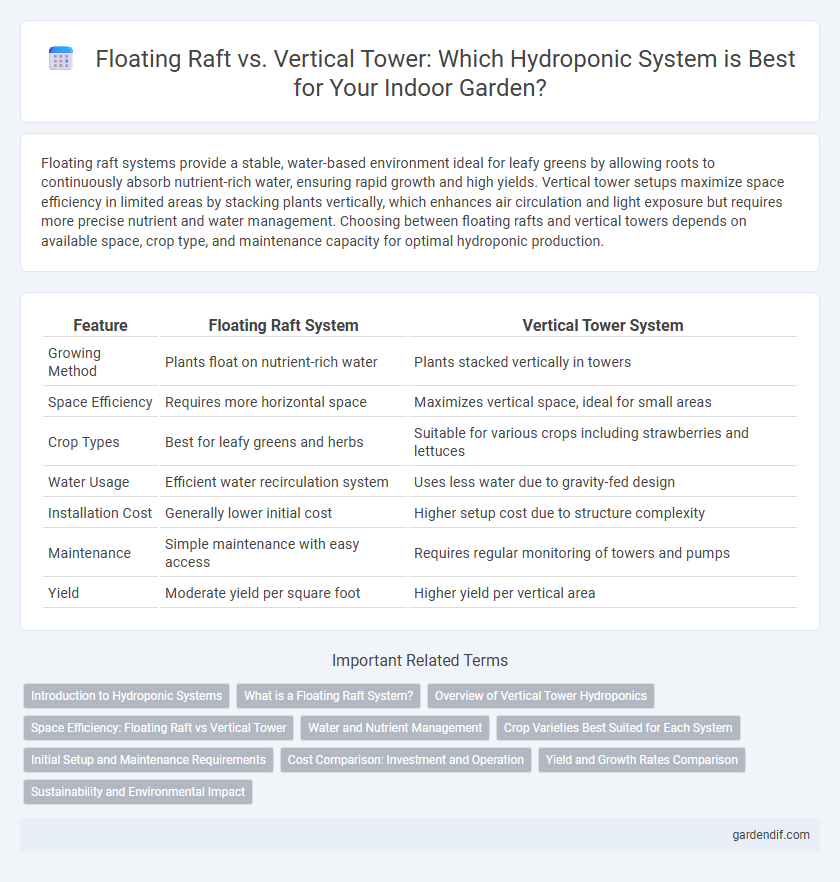
Floating Raft vs Vertical Tower Illustration
Floating raft systems provide a stable, water-based environment ideal for leafy greens by allowing roots to continuously absorb nutrient-rich water, ensuring rapid growth and high yields. Vertical tower setups maximize space efficiency in limited areas by stacking plants vertically, which enhances air circulation and light exposure but requires more precise nutrient and water management. Choosing between floating rafts and vertical towers depends on available space, crop type, and maintenance capacity for optimal hydroponic production.
Table of Comparison
| Feature | Floating Raft System | Vertical Tower System |
|---|---|---|
| Growing Method | Plants float on nutrient-rich water | Plants stacked vertically in towers |
| Space Efficiency | Requires more horizontal space | Maximizes vertical space, ideal for small areas |
| Crop Types | Best for leafy greens and herbs | Suitable for various crops including strawberries and lettuces |
| Water Usage | Efficient water recirculation system | Uses less water due to gravity-fed design |
| Installation Cost | Generally lower initial cost | Higher setup cost due to structure complexity |
| Maintenance | Simple maintenance with easy access | Requires regular monitoring of towers and pumps |
| Yield | Moderate yield per square foot | Higher yield per vertical area |
Introduction to Hydroponic Systems
Floating raft systems use buoyant platforms to support plants in nutrient-rich water, offering high oxygen availability and efficient root development. Vertical tower systems maximize space by stacking plants vertically, ideal for urban environments and limited areas, while ensuring efficient nutrient delivery through drip irrigation. Both systems provide soil-less cultivation, enhancing water use efficiency and promoting faster plant growth compared to traditional methods.
What is a Floating Raft System?
A Floating Raft System in hydroponics consists of plants supported on buoyant rafts that float on nutrient-rich water, allowing roots to be constantly submerged for optimal oxygen and nutrient absorption. This method is highly effective for leafy greens and herbs due to its steady nutrient delivery and stable environment. Compared to Vertical Tower systems, Floating Rafts enable faster growth rates and easier maintenance in controlled settings.
Overview of Vertical Tower Hydroponics
Vertical tower hydroponics maximizes space by stacking plants in a vertical system, making it ideal for urban and indoor farming environments. This method uses nutrient-rich water circulated through the tower, promoting efficient nutrient absorption and faster plant growth. Compared to floating raft systems, vertical towers reduce water usage and support a wider variety of crops, including leafy greens and herbs.
Space Efficiency: Floating Raft vs Vertical Tower
Floating raft systems require a larger horizontal footprint, making them less space-efficient for small or urban environments. Vertical tower systems maximize space by utilizing vertical growth, allowing for higher plant density per square foot. This vertical design significantly improves space efficiency compared to traditional floating raft setups.
Water and Nutrient Management
Floating raft systems provide superior water and nutrient management by continuously circulating nutrient-rich water around plant roots, ensuring optimal oxygenation and nutrient uptake. Vertical tower systems optimize space but may encounter uneven water distribution and nutrient delivery, requiring precise control to avoid dry spots and nutrient deficiencies. Efficient management in both systems relies on monitoring pH, electrical conductivity (EC), and oxygen levels to maintain optimal hydroponic conditions.
Crop Varieties Best Suited for Each System
Floating raft systems excel in growing leafy greens such as lettuce, spinach, and herbs due to their steady water nutrient supply and ease of root access. Vertical tower systems are ideal for vine crops and fruiting plants like tomatoes, strawberries, and peppers, offering space efficiency and optimized light exposure. Selecting the right hydroponic system depends on the specific crop's growth habits and space requirements.
Initial Setup and Maintenance Requirements
Floating raft hydroponic systems require a larger initial setup area with water reservoirs and sturdy rafts, while vertical tower systems demand precision in assembling multi-level structures and integrated irrigation lines. Maintenance for floating rafts involves regular nutrient solution monitoring and algae control, whereas vertical towers require frequent inspection of water flow through tubing and periodic cleaning to prevent clogs. The vertical tower's compact design reduces space needs but increases the complexity of system upkeep compared to the simpler floating raft maintenance.
Cost Comparison: Investment and Operation
Floating raft systems typically require a higher initial investment due to the need for large water reservoirs and durable raft materials, while vertical tower setups often have lower startup costs because of their compact design and scalable components. Operational expenses for floating rafts include consistent water management and aeration, which can increase energy consumption, whereas vertical towers demand more frequent nutrient solution circulation but benefit from reduced water usage and space efficiency. Cost-effectiveness depends on crop type and production scale, with floating rafts favoring leafy greens and larger operations, and vertical towers suited for high-density, space-limited environments.
Yield and Growth Rates Comparison
Floating raft systems typically deliver higher yields and faster growth rates due to continuous nutrient delivery and stable root zones, promoting uniform plant development. Vertical tower hydroponics maximize space efficiency but may exhibit slightly slower growth rates and reduced yields as nutrient distribution can be less consistent across stacked layers. Optimizing nutrient flow and lighting in vertical towers can narrow the gap, but floating rafts remain superior for maximizing yield and growth speed in hydroponic cultivation.
Sustainability and Environmental Impact
Floating raft systems maximize water efficiency by recirculating nutrient solutions, reducing water waste by up to 90% compared to traditional farming, and minimizing energy consumption due to their passive design. Vertical tower hydroponics optimize space usage, enabling higher crop yields per square meter, which supports urban agriculture and reduces land footprint, but they often require more energy for pumps and artificial lighting. Both methods lower pesticide use and soil degradation, contributing positively to sustainability, with floating rafts excelling in water conservation and vertical towers favoring land-use efficiency.
Floating Raft vs Vertical Tower Infographic

 gardendif.com
gardendif.com